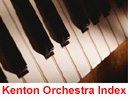|
Out of the Bell Kevin Lindsay Kevin Lindsay, a born-and-raised Alaskan, was a student of Clyde Miller and
William Scharnberg at North Texas and worked with L.A. horn players Kurt with the symphony, opera, and other performing groups when he has the time
(and they are desperate). He is, however, the first-call mellophonium player
in the area. Contact him at: klindsay@alaska.net |
|
When a lab band was working on an arrangement that required horns, including many of the Kenton works, the excellent but difficult Rob McConnell pieces, or a student project, I was often the first horn player approached to play. The reasons for this probably had less to do with my horn-playing skill (modest at best) or my ability to swing a little (still rare among horn players ask any trumpet or trombone player), than with my carefully cultivated ability to match many of the jazz musicians beer-for-beer. This bell-front instrument was produced by C.G. Conn, pitched in F-alto, to Kenton's precise specifications around 1960 (this date is not universally accepted). This article is not intended to be a history of the mellophonium, since several comprehensive accounts, such as Scooter Pirtle's excellent article of its use in the Kenton band can be found when you return to the Kenton Orchestra Index and click on 'The Kenton Mellophonium Section'. But when I was called to play a holiday choral concert with brass choir, and found that the "lollipops" part of the program included three of Kenton's Christmas carol arrangements for brass, decided to seize the opportunity to try something different.
My first impressions were: the horn mouthpiece rattles in the receiver, but I expected this, knowing that the instrument was designed to use a mellophone mouthpiece. The long-awaited sound, on first try, was reminiscent of a marching French horn, or perhaps a bad high school horn player, just converted from trumpet and still resistant to the idea of placing the hand in the bell: raucous and blatty would be properly descriptive terms. There was no need to find my electronic tuner; it was clear that both the valve combinations and the harmonic series was out of whack. The first solution that came to mind (other than mounting it on a wall as a decoration) was to take it out into my garage, remove its mouth pipe with a torch, and replace it with a spare pipe that I had taken off of an old Schmidt B-flat horn. This, I felt, would allowed me to use a horn mouthpiece without an adapter (which cause venturi problems of their own) and, hopefully, improve the harmonic series. This solution was dashed by the fact that the mellophonium lead pipe is both half the length of a horn lead pipe and much larger in bore. In a moment of inspiration, I cut the Schmidt pipe mouthpiece receiver and about two inches of the pipe with a plumbing pipe cutter, used the torch to remove the mellophonium mouthpiece the receiver, and tapped the Schmidt piece into the mellophonium lead pipe with a mallet. Voila! The mellophonium now accepted a horn mouthpiece with a much smoother taper transition than a mouthpiece adapter would have allowed. I put in a horn mouthpiece and prepared to assess the mellophonium's playing "qualities."
The hand position for playing it is surprisingly comfortable: the piston valves take a little getting used to but the finger hook fits my hand just fine. The overall balance isn't bad either, despite the long bell, due to Conn's foresight in putting a trombone counterweight at the rear of the instrument. Choosing a mouthpiece for my customized mellophonium was a little more problematic than I had anticipated. Now my regular playing equipment is pretty standard, especially when compared to the cutting-edge pro world. I am currently in a phase of my playing career where different horns pretty much play the same for me I find that I can miss notes with equal consistency on just about any instrument. My main axe is a beat-up old M-series 8D (truly the Ford F-250 pickup truck of the horn world and I have a fabulous sounding, but extremely treacherous pre-WWII Schmidt Bb horn with a modern Engelbert Schmid lead pipe for a graduation gift from Dr. Scharnberg, replacing the terrible OEM pipe and eventually used to modify the mellophonium. I have three Atkinson cups, a Cl (supposedly a copy of DeRosa's old Giardinelli Cl mouth-piece), an H (Horner) 8, and a D(Dellosa)12. I use a thin rim and choose the cup depending on the playing situation (Cl for low horn, H8 for big, heroic playing, and the D12 after quickly realizing that I am way too out-of-shape to even think about playing the H8). I also have an old Giardinelli S14 that is great for small ensembles. My plan for the mellophonium was to ameliorate the harsh tone by using a big, deep horn mouth-piece, such as the H8. What a bad idea. The larger horn mouthpiece cups did indeed allow for a fuller, more horn-like sound, but their free-blowing characteristics, combined with the almost total lack of resistance of the mellophonium left me with very little endurance and virtually no high range. Not for the last time in this endeavor did it cross my mind that the guys in the Kenton band who played these things must have been beasts. Sure, the cup-shaped mellophone or cornet mouth-pieces that they used would have helped range and endurance, but I still stand in awe of their brute strength.I am quite sure that a DeRosa, Myers, Thatcher, etc. would have no problem but I was going to need more of a real-world solution. I dug into the box that serves as my mouthpiece graveyard and soon found what I was looking for: an Alexander 4 mouthpiece. The Alex 4, according to Toru Ikeno's excellent mouthpiece comparison is the smallest production horn mouthpiece made (sort of the Schilke 6a4a of the horn world). I have no idea why I own one of these, but probably acquired it as part of a grab bag purchase. Anyway, the Alex pretty much solved my range and endurance problems but at the cost of tone quality. I practiced for a few days on both horn and mellophonium, then it was off to the first rehearsal.
Whatever the case, it was nigh impossible to play in tune with any other instrument. After a discouraging first rehearsal, I began to wonder if perhaps I should give up on my experiment and return to my 8D (I was already using it for the non-Kenton portions of the concert). Luckily, the choir conductor (himself a fine trumpet player) was fascinated by the mellophone and encouraged me to persevere. So the next day I returned to my garage and, using a Dremel tool, cut approximately half an inch off of each valve slide. Problem solved! The mellophonium was now playable in an ensemble. This is exactly what Stan and Johnny Richards did after deciding, following a late night (very late night) dinner to re-tool the instrument by using a hack saw to remove a half-inch or two off each valve slide. In closing, the mellophonium is truly fascinating, but not terribly easy to play. It was amazing to me how its rough, powerful voice
completely changed the sound and style of the brass choir. When the Kenton pieces are played using horns on those parts, the other
brass players are forced to be more civilized and tasteful in their playing. But then the effect is really more of a brass choir, not a jazz
band. The use of the mellophonium, with its ability to match trumpet and trombones decibel-for-decibel and its more aggressive sound,
allows the entire brass section to be unleashed: certainly the sound that Kenton originally had in mind. What a blast (literally)!
|
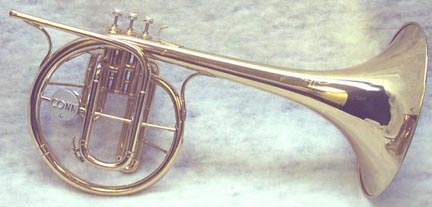 Performing Stan Kenton's Music on the
Original Instrument, or The Mellophonium:
Performing Stan Kenton's Music on the
Original Instrument, or The Mellophonium: 
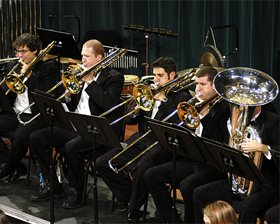 First a little history:
as a horn student at North Texas State University (now University of North
Texas) in the early-to-mid 1980s, one of the most unique and enjoyable
opportunities afforded me in my studies was that of performing a number of Stan Kenton's big band arrangements with its excellent 'Lab' jazz bands. When Kenton passed away in 1979, his will awarded custody of his entire music library to UNT.
After cataloging and filing, a process that took nearly a year, the music
was made available to faculty and students, and the directors of the
various lab bands wasted no time in taking advantage of these
arrangements.
First a little history:
as a horn student at North Texas State University (now University of North
Texas) in the early-to-mid 1980s, one of the most unique and enjoyable
opportunities afforded me in my studies was that of performing a number of Stan Kenton's big band arrangements with its excellent 'Lab' jazz bands. When Kenton passed away in 1979, his will awarded custody of his entire music library to UNT.
After cataloging and filing, a process that took nearly a year, the music
was made available to faculty and students, and the directors of the
various lab bands wasted no time in taking advantage of these
arrangements.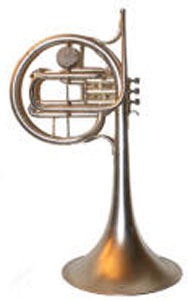 Within a few days, found several candidates. The production version of the
Kenton/Conn mellophonium was available in two finishes:
silver plate or the more common traditional brass lacquer. I found two
silver mellophoniums for sale, but one had been fully restored and
was priced at over $1000, and the other looked like it had been literally
run over by a truck. I opted for a brass mellophonium that had
apparently been used as a marching band horn at the University of
North Carolina. It was fully functional, although it had the rather
crinkled look so common to marching horns, and I was able to get it for
the much more approachable price of 80 bucks. It arrived at my
home in Anchorage, Alaska in about two weeks. My wife commented that I was
like a little kid when I unboxed my new toy and, after
loosening the piston valves, I grabbed a handy horn mouthpiece, put it in
the mouthpiece receiver, and tried a few notes.
Within a few days, found several candidates. The production version of the
Kenton/Conn mellophonium was available in two finishes:
silver plate or the more common traditional brass lacquer. I found two
silver mellophoniums for sale, but one had been fully restored and
was priced at over $1000, and the other looked like it had been literally
run over by a truck. I opted for a brass mellophonium that had
apparently been used as a marching band horn at the University of
North Carolina. It was fully functional, although it had the rather
crinkled look so common to marching horns, and I was able to get it for
the much more approachable price of 80 bucks. It arrived at my
home in Anchorage, Alaska in about two weeks. My wife commented that I was
like a little kid when I unboxed my new toy and, after
loosening the piston valves, I grabbed a handy horn mouthpiece, put it in
the mouthpiece receiver, and tried a few notes.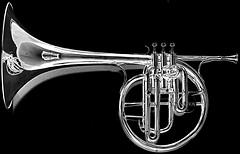 Okay, this thing has absolutely no resistance. Think of it as a bell-front descant horn with a bore of .500 (same as the average small-bore trombone), and you'll get some idea of the free-blowing nature of the instrument. The pitch centers above top-space G are almost non-existent. The effect is similar to that of playing an F horn from G to high C without the hand in the bell-more of a glissando than a defined scale. This puzzled me since, on the mellophonium, this range fell between the 6th and 8th harmonics, rather than the 12th and 16th.
Okay, this thing has absolutely no resistance. Think of it as a bell-front descant horn with a bore of .500 (same as the average small-bore trombone), and you'll get some idea of the free-blowing nature of the instrument. The pitch centers above top-space G are almost non-existent. The effect is similar to that of playing an F horn from G to high C without the hand in the bell-more of a glissando than a defined scale. This puzzled me since, on the mellophonium, this range fell between the 6th and 8th harmonics, rather than the 12th and 16th.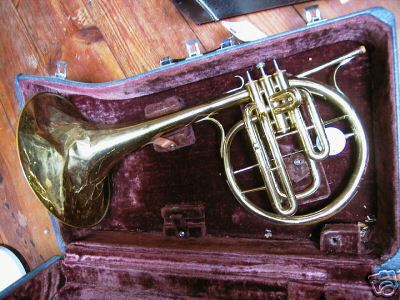 The looks on the faces of my brass colleagues when I casually took the mellophonium
out of its case and began warming up were priceless. Their comments were varied but all essentially boiled down to "what in hell is that?" All pleasantries ceased, however, when we began to rehearse the Kenton pieces. First of all, even with practice, my intonation was less than perfect. Strangely, when I checked it with a tuner, most of the open partials in the range that I was playing in were pretty close to where they should be. All of the valve combinations, however, were flat, even 1st and 2nd valve notes were very difficult to get up to pitch. All mellophoniums came from Conn with a tuning slide extension to put
them into Eb-alto, so perhaps the valve slide lengths were a compromise between the two pitches.
The looks on the faces of my brass colleagues when I casually took the mellophonium
out of its case and began warming up were priceless. Their comments were varied but all essentially boiled down to "what in hell is that?" All pleasantries ceased, however, when we began to rehearse the Kenton pieces. First of all, even with practice, my intonation was less than perfect. Strangely, when I checked it with a tuner, most of the open partials in the range that I was playing in were pretty close to where they should be. All of the valve combinations, however, were flat, even 1st and 2nd valve notes were very difficult to get up to pitch. All mellophoniums came from Conn with a tuning slide extension to put
them into Eb-alto, so perhaps the valve slide lengths were a compromise between the two pitches.

